SAP103 Introduction to Welfare Law: Analysis of Child Custody Case
VerifiedAdded on 2022/10/17
|7
|1695
|9
Report
AI Summary
This report provides an overview of Australian child custody law, focusing on the Children's Court of Victoria and the legal framework surrounding child protection and welfare. It examines a specific custody hearing case at the Parramatta Children's Court of New South Wales, involving a dispute between unmarried parents over their five-year-old son. The report delves into the application of the Australian child custody law, which emphasizes the importance of a meaningful relationship with both parents and the child's protection from harm. It discusses the concept of shared parental responsibility, the presumption of equal time, and the factors considered by the court when making custody orders. The case analysis highlights the judge's decision to grant the child time with both parents, emphasizing the importance of the child's well-being and the need for the child to develop a relationship with both parents. The report concludes by summarizing the key aspects of the case and the court's final ruling, underscoring the significance of amicable resolutions in family disputes and the prioritization of the child's best interests throughout the legal process. The report also includes references to relevant legislation and academic sources.
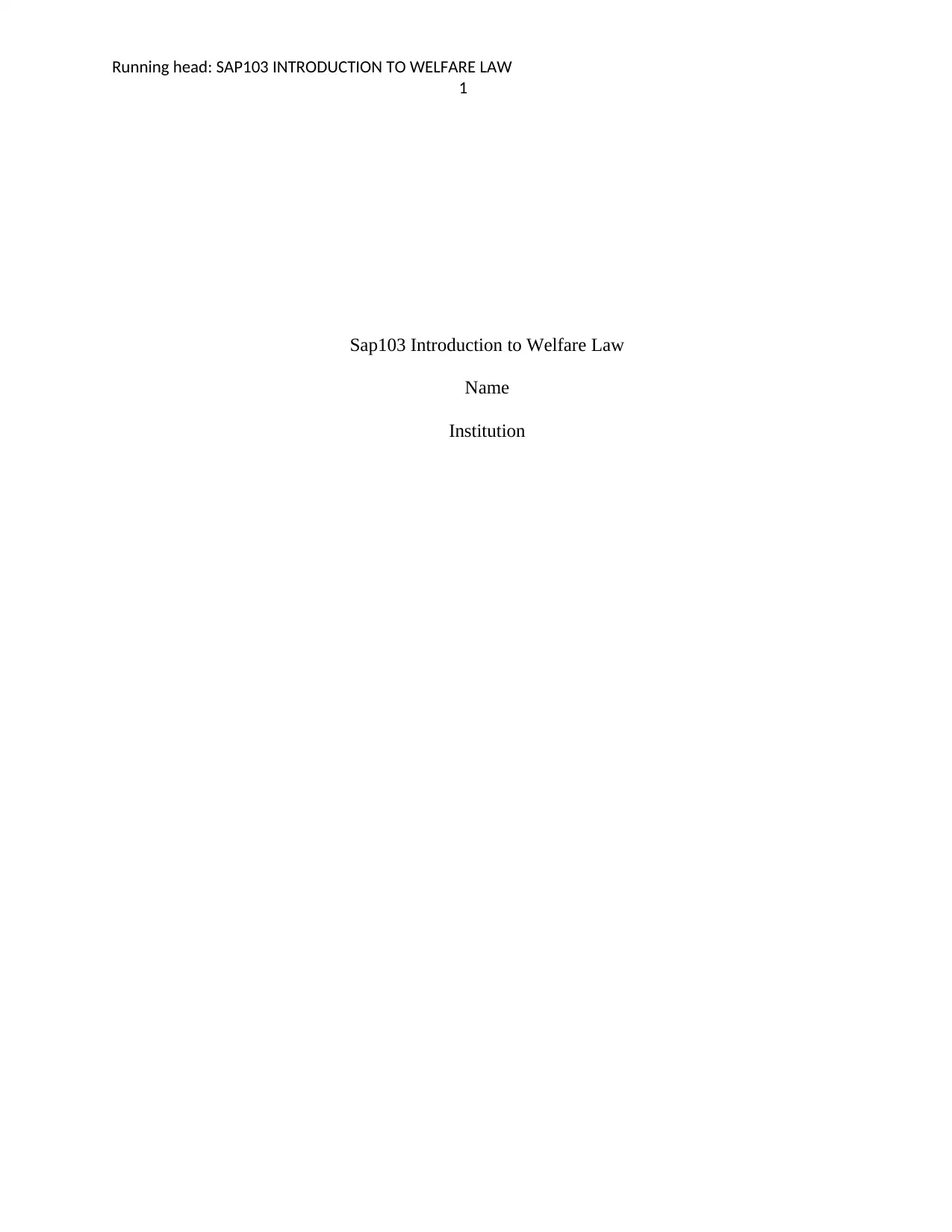
Running head: SAP103 INTRODUCTION TO WELFARE LAW
1
Sap103 Introduction to Welfare Law
Name
Institution
1
Sap103 Introduction to Welfare Law
Name
Institution
Paraphrase This Document
Need a fresh take? Get an instant paraphrase of this document with our AI Paraphraser
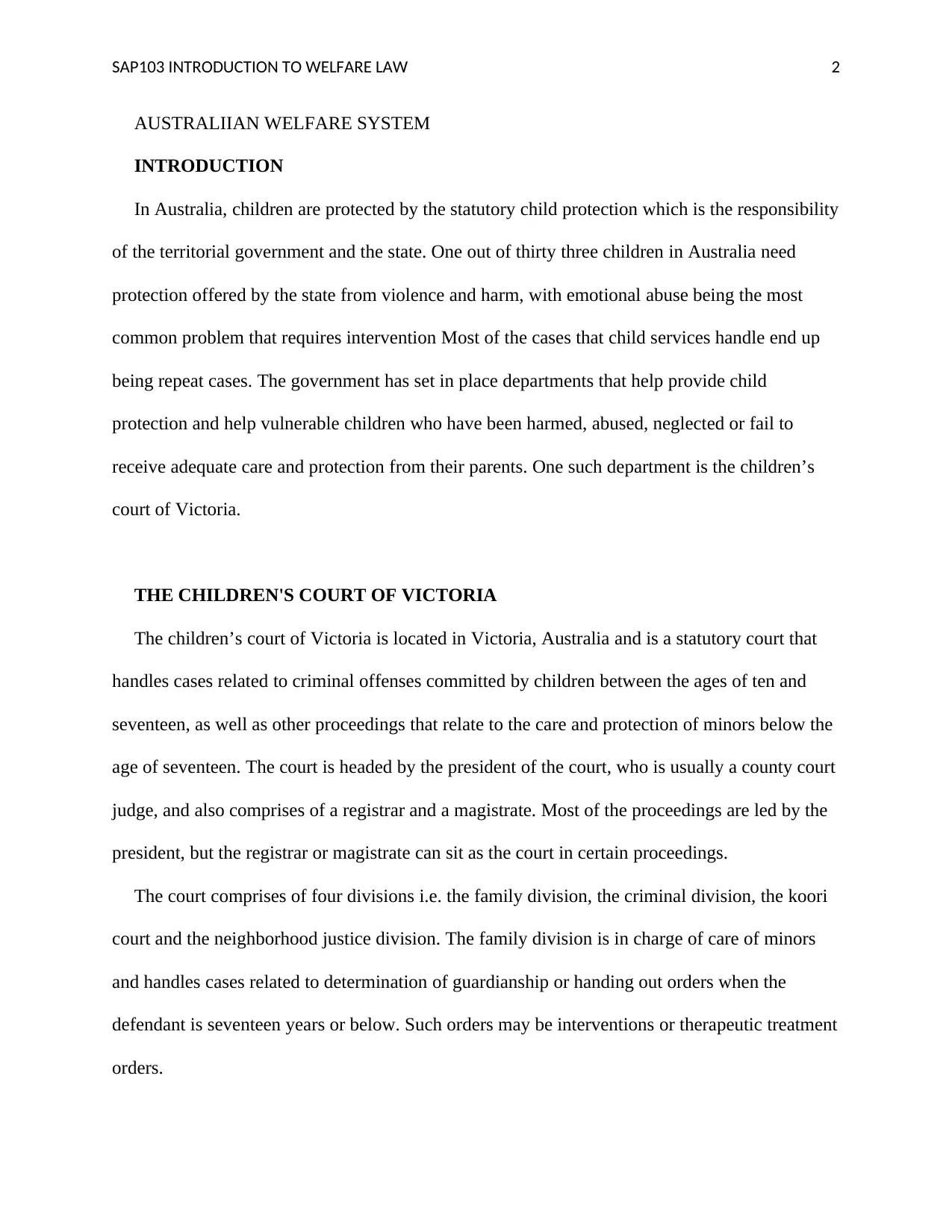
SAP103 INTRODUCTION TO WELFARE LAW 2
AUSTRALIIAN WELFARE SYSTEM
INTRODUCTION
In Australia, children are protected by the statutory child protection which is the responsibility
of the territorial government and the state. One out of thirty three children in Australia need
protection offered by the state from violence and harm, with emotional abuse being the most
common problem that requires intervention Most of the cases that child services handle end up
being repeat cases. The government has set in place departments that help provide child
protection and help vulnerable children who have been harmed, abused, neglected or fail to
receive adequate care and protection from their parents. One such department is the children’s
court of Victoria.
THE CHILDREN'S COURT OF VICTORIA
The children’s court of Victoria is located in Victoria, Australia and is a statutory court that
handles cases related to criminal offenses committed by children between the ages of ten and
seventeen, as well as other proceedings that relate to the care and protection of minors below the
age of seventeen. The court is headed by the president of the court, who is usually a county court
judge, and also comprises of a registrar and a magistrate. Most of the proceedings are led by the
president, but the registrar or magistrate can sit as the court in certain proceedings.
The court comprises of four divisions i.e. the family division, the criminal division, the koori
court and the neighborhood justice division. The family division is in charge of care of minors
and handles cases related to determination of guardianship or handing out orders when the
defendant is seventeen years or below. Such orders may be interventions or therapeutic treatment
orders.
AUSTRALIIAN WELFARE SYSTEM
INTRODUCTION
In Australia, children are protected by the statutory child protection which is the responsibility
of the territorial government and the state. One out of thirty three children in Australia need
protection offered by the state from violence and harm, with emotional abuse being the most
common problem that requires intervention Most of the cases that child services handle end up
being repeat cases. The government has set in place departments that help provide child
protection and help vulnerable children who have been harmed, abused, neglected or fail to
receive adequate care and protection from their parents. One such department is the children’s
court of Victoria.
THE CHILDREN'S COURT OF VICTORIA
The children’s court of Victoria is located in Victoria, Australia and is a statutory court that
handles cases related to criminal offenses committed by children between the ages of ten and
seventeen, as well as other proceedings that relate to the care and protection of minors below the
age of seventeen. The court is headed by the president of the court, who is usually a county court
judge, and also comprises of a registrar and a magistrate. Most of the proceedings are led by the
president, but the registrar or magistrate can sit as the court in certain proceedings.
The court comprises of four divisions i.e. the family division, the criminal division, the koori
court and the neighborhood justice division. The family division is in charge of care of minors
and handles cases related to determination of guardianship or handing out orders when the
defendant is seventeen years or below. Such orders may be interventions or therapeutic treatment
orders.
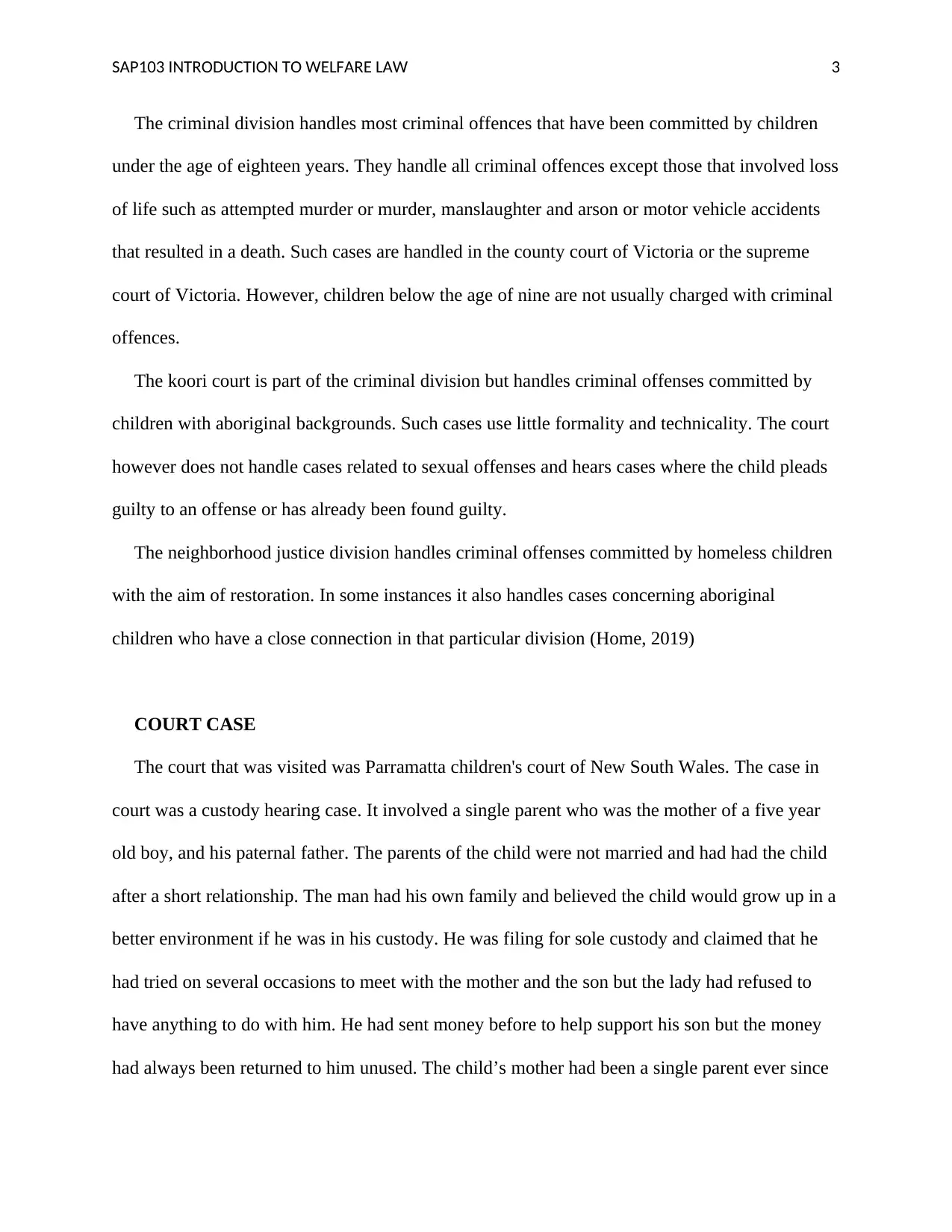
SAP103 INTRODUCTION TO WELFARE LAW 3
The criminal division handles most criminal offences that have been committed by children
under the age of eighteen years. They handle all criminal offences except those that involved loss
of life such as attempted murder or murder, manslaughter and arson or motor vehicle accidents
that resulted in a death. Such cases are handled in the county court of Victoria or the supreme
court of Victoria. However, children below the age of nine are not usually charged with criminal
offences.
The koori court is part of the criminal division but handles criminal offenses committed by
children with aboriginal backgrounds. Such cases use little formality and technicality. The court
however does not handle cases related to sexual offenses and hears cases where the child pleads
guilty to an offense or has already been found guilty.
The neighborhood justice division handles criminal offenses committed by homeless children
with the aim of restoration. In some instances it also handles cases concerning aboriginal
children who have a close connection in that particular division (Home, 2019)
COURT CASE
The court that was visited was Parramatta children's court of New South Wales. The case in
court was a custody hearing case. It involved a single parent who was the mother of a five year
old boy, and his paternal father. The parents of the child were not married and had had the child
after a short relationship. The man had his own family and believed the child would grow up in a
better environment if he was in his custody. He was filing for sole custody and claimed that he
had tried on several occasions to meet with the mother and the son but the lady had refused to
have anything to do with him. He had sent money before to help support his son but the money
had always been returned to him unused. The child’s mother had been a single parent ever since
The criminal division handles most criminal offences that have been committed by children
under the age of eighteen years. They handle all criminal offences except those that involved loss
of life such as attempted murder or murder, manslaughter and arson or motor vehicle accidents
that resulted in a death. Such cases are handled in the county court of Victoria or the supreme
court of Victoria. However, children below the age of nine are not usually charged with criminal
offences.
The koori court is part of the criminal division but handles criminal offenses committed by
children with aboriginal backgrounds. Such cases use little formality and technicality. The court
however does not handle cases related to sexual offenses and hears cases where the child pleads
guilty to an offense or has already been found guilty.
The neighborhood justice division handles criminal offenses committed by homeless children
with the aim of restoration. In some instances it also handles cases concerning aboriginal
children who have a close connection in that particular division (Home, 2019)
COURT CASE
The court that was visited was Parramatta children's court of New South Wales. The case in
court was a custody hearing case. It involved a single parent who was the mother of a five year
old boy, and his paternal father. The parents of the child were not married and had had the child
after a short relationship. The man had his own family and believed the child would grow up in a
better environment if he was in his custody. He was filing for sole custody and claimed that he
had tried on several occasions to meet with the mother and the son but the lady had refused to
have anything to do with him. He had sent money before to help support his son but the money
had always been returned to him unused. The child’s mother had been a single parent ever since
⊘ This is a preview!⊘
Do you want full access?
Subscribe today to unlock all pages.

Trusted by 1+ million students worldwide
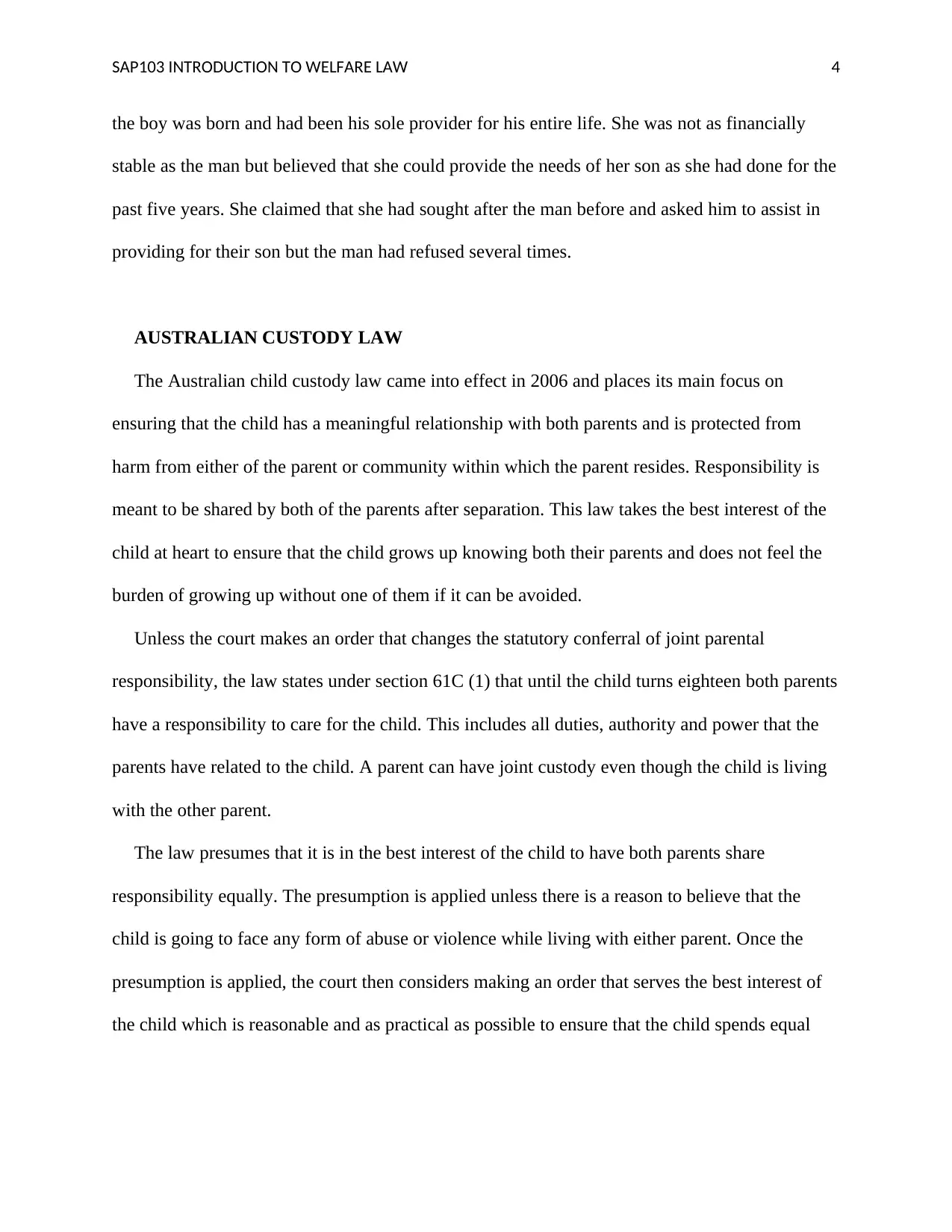
SAP103 INTRODUCTION TO WELFARE LAW 4
the boy was born and had been his sole provider for his entire life. She was not as financially
stable as the man but believed that she could provide the needs of her son as she had done for the
past five years. She claimed that she had sought after the man before and asked him to assist in
providing for their son but the man had refused several times.
AUSTRALIAN CUSTODY LAW
The Australian child custody law came into effect in 2006 and places its main focus on
ensuring that the child has a meaningful relationship with both parents and is protected from
harm from either of the parent or community within which the parent resides. Responsibility is
meant to be shared by both of the parents after separation. This law takes the best interest of the
child at heart to ensure that the child grows up knowing both their parents and does not feel the
burden of growing up without one of them if it can be avoided.
Unless the court makes an order that changes the statutory conferral of joint parental
responsibility, the law states under section 61C (1) that until the child turns eighteen both parents
have a responsibility to care for the child. This includes all duties, authority and power that the
parents have related to the child. A parent can have joint custody even though the child is living
with the other parent.
The law presumes that it is in the best interest of the child to have both parents share
responsibility equally. The presumption is applied unless there is a reason to believe that the
child is going to face any form of abuse or violence while living with either parent. Once the
presumption is applied, the court then considers making an order that serves the best interest of
the child which is reasonable and as practical as possible to ensure that the child spends equal
the boy was born and had been his sole provider for his entire life. She was not as financially
stable as the man but believed that she could provide the needs of her son as she had done for the
past five years. She claimed that she had sought after the man before and asked him to assist in
providing for their son but the man had refused several times.
AUSTRALIAN CUSTODY LAW
The Australian child custody law came into effect in 2006 and places its main focus on
ensuring that the child has a meaningful relationship with both parents and is protected from
harm from either of the parent or community within which the parent resides. Responsibility is
meant to be shared by both of the parents after separation. This law takes the best interest of the
child at heart to ensure that the child grows up knowing both their parents and does not feel the
burden of growing up without one of them if it can be avoided.
Unless the court makes an order that changes the statutory conferral of joint parental
responsibility, the law states under section 61C (1) that until the child turns eighteen both parents
have a responsibility to care for the child. This includes all duties, authority and power that the
parents have related to the child. A parent can have joint custody even though the child is living
with the other parent.
The law presumes that it is in the best interest of the child to have both parents share
responsibility equally. The presumption is applied unless there is a reason to believe that the
child is going to face any form of abuse or violence while living with either parent. Once the
presumption is applied, the court then considers making an order that serves the best interest of
the child which is reasonable and as practical as possible to ensure that the child spends equal
Paraphrase This Document
Need a fresh take? Get an instant paraphrase of this document with our AI Paraphraser
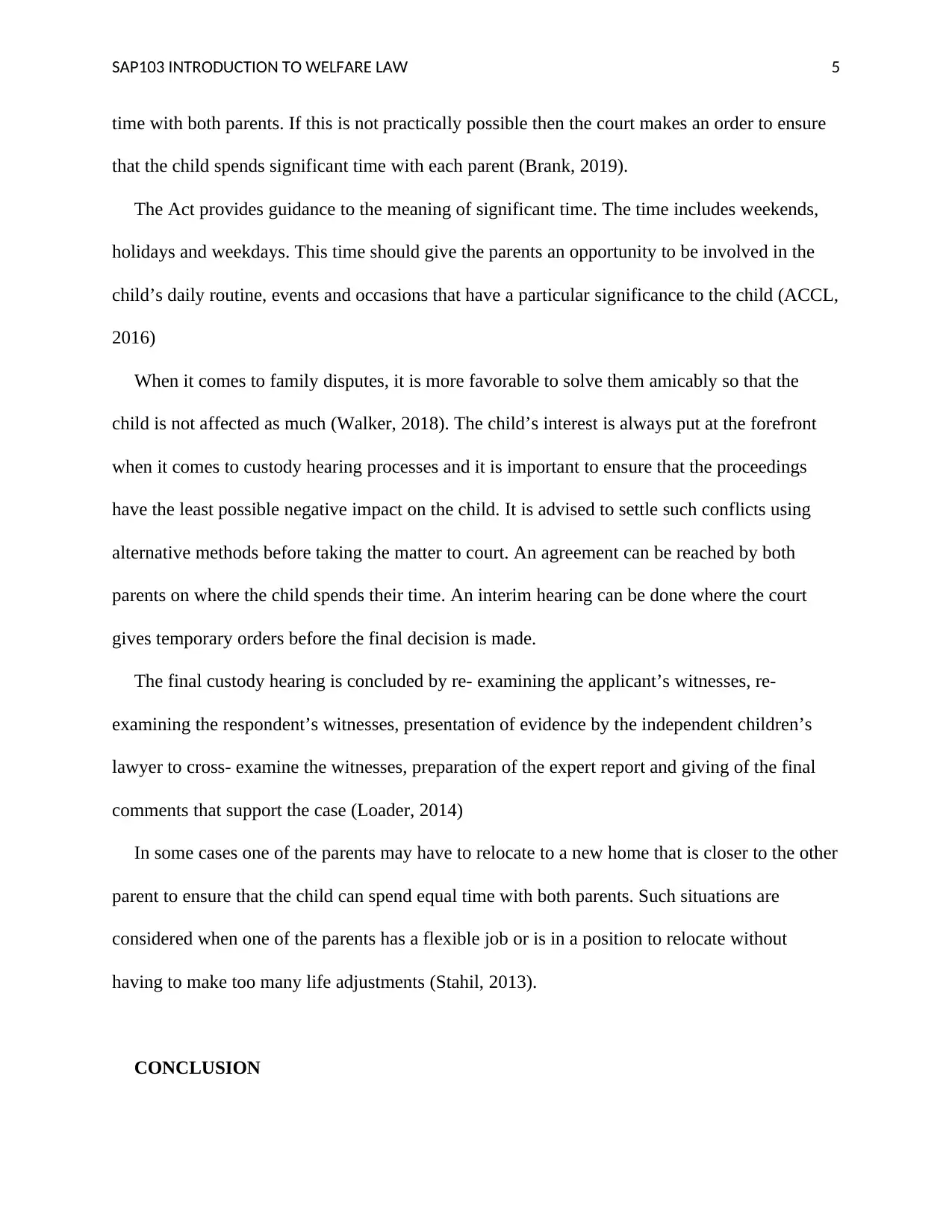
SAP103 INTRODUCTION TO WELFARE LAW 5
time with both parents. If this is not practically possible then the court makes an order to ensure
that the child spends significant time with each parent (Brank, 2019).
The Act provides guidance to the meaning of significant time. The time includes weekends,
holidays and weekdays. This time should give the parents an opportunity to be involved in the
child’s daily routine, events and occasions that have a particular significance to the child (ACCL,
2016)
When it comes to family disputes, it is more favorable to solve them amicably so that the
child is not affected as much (Walker, 2018). The child’s interest is always put at the forefront
when it comes to custody hearing processes and it is important to ensure that the proceedings
have the least possible negative impact on the child. It is advised to settle such conflicts using
alternative methods before taking the matter to court. An agreement can be reached by both
parents on where the child spends their time. An interim hearing can be done where the court
gives temporary orders before the final decision is made.
The final custody hearing is concluded by re- examining the applicant’s witnesses, re-
examining the respondent’s witnesses, presentation of evidence by the independent children’s
lawyer to cross- examine the witnesses, preparation of the expert report and giving of the final
comments that support the case (Loader, 2014)
In some cases one of the parents may have to relocate to a new home that is closer to the other
parent to ensure that the child can spend equal time with both parents. Such situations are
considered when one of the parents has a flexible job or is in a position to relocate without
having to make too many life adjustments (Stahil, 2013).
CONCLUSION
time with both parents. If this is not practically possible then the court makes an order to ensure
that the child spends significant time with each parent (Brank, 2019).
The Act provides guidance to the meaning of significant time. The time includes weekends,
holidays and weekdays. This time should give the parents an opportunity to be involved in the
child’s daily routine, events and occasions that have a particular significance to the child (ACCL,
2016)
When it comes to family disputes, it is more favorable to solve them amicably so that the
child is not affected as much (Walker, 2018). The child’s interest is always put at the forefront
when it comes to custody hearing processes and it is important to ensure that the proceedings
have the least possible negative impact on the child. It is advised to settle such conflicts using
alternative methods before taking the matter to court. An agreement can be reached by both
parents on where the child spends their time. An interim hearing can be done where the court
gives temporary orders before the final decision is made.
The final custody hearing is concluded by re- examining the applicant’s witnesses, re-
examining the respondent’s witnesses, presentation of evidence by the independent children’s
lawyer to cross- examine the witnesses, preparation of the expert report and giving of the final
comments that support the case (Loader, 2014)
In some cases one of the parents may have to relocate to a new home that is closer to the other
parent to ensure that the child can spend equal time with both parents. Such situations are
considered when one of the parents has a flexible job or is in a position to relocate without
having to make too many life adjustments (Stahil, 2013).
CONCLUSION
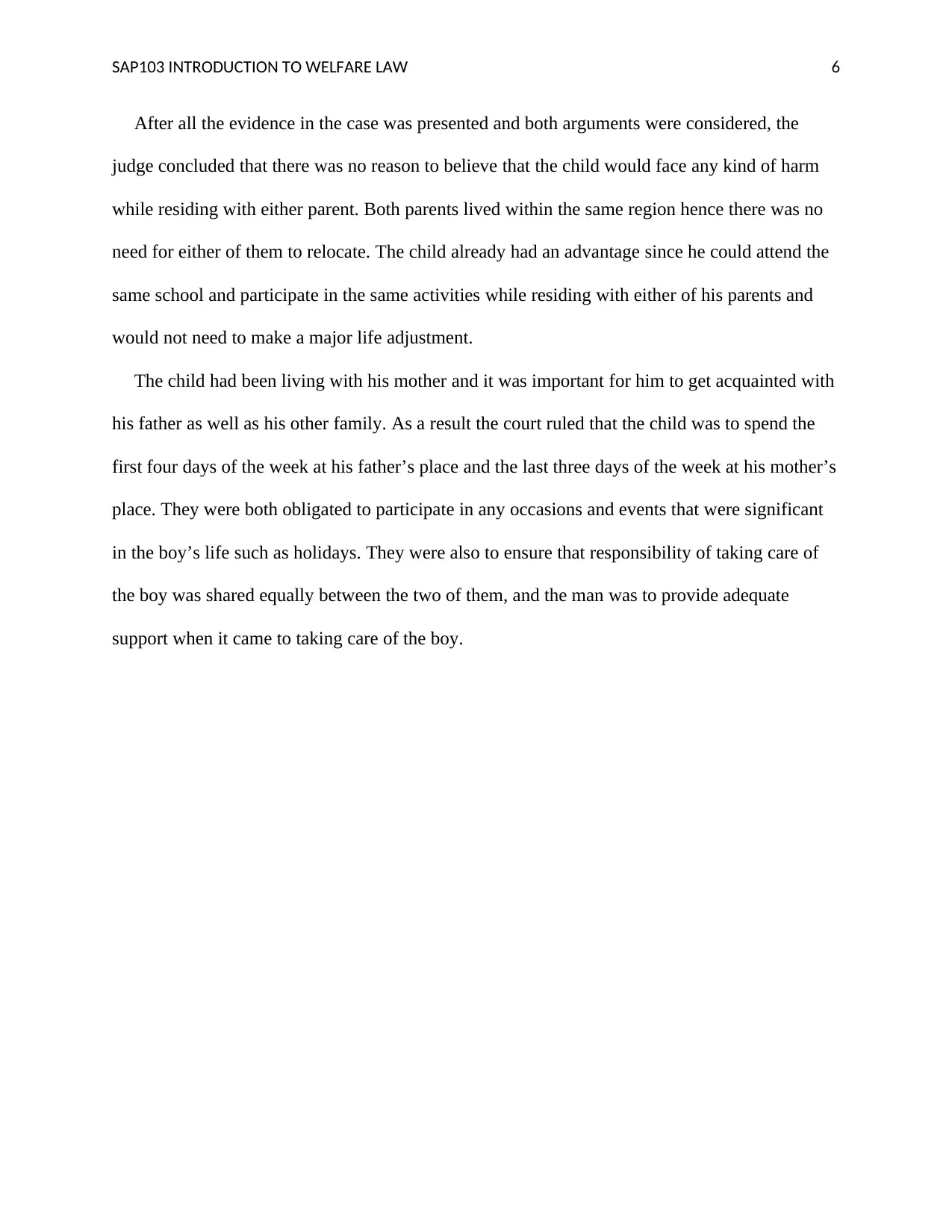
SAP103 INTRODUCTION TO WELFARE LAW 6
After all the evidence in the case was presented and both arguments were considered, the
judge concluded that there was no reason to believe that the child would face any kind of harm
while residing with either parent. Both parents lived within the same region hence there was no
need for either of them to relocate. The child already had an advantage since he could attend the
same school and participate in the same activities while residing with either of his parents and
would not need to make a major life adjustment.
The child had been living with his mother and it was important for him to get acquainted with
his father as well as his other family. As a result the court ruled that the child was to spend the
first four days of the week at his father’s place and the last three days of the week at his mother’s
place. They were both obligated to participate in any occasions and events that were significant
in the boy’s life such as holidays. They were also to ensure that responsibility of taking care of
the boy was shared equally between the two of them, and the man was to provide adequate
support when it came to taking care of the boy.
After all the evidence in the case was presented and both arguments were considered, the
judge concluded that there was no reason to believe that the child would face any kind of harm
while residing with either parent. Both parents lived within the same region hence there was no
need for either of them to relocate. The child already had an advantage since he could attend the
same school and participate in the same activities while residing with either of his parents and
would not need to make a major life adjustment.
The child had been living with his mother and it was important for him to get acquainted with
his father as well as his other family. As a result the court ruled that the child was to spend the
first four days of the week at his father’s place and the last three days of the week at his mother’s
place. They were both obligated to participate in any occasions and events that were significant
in the boy’s life such as holidays. They were also to ensure that responsibility of taking care of
the boy was shared equally between the two of them, and the man was to provide adequate
support when it came to taking care of the boy.
⊘ This is a preview!⊘
Do you want full access?
Subscribe today to unlock all pages.

Trusted by 1+ million students worldwide
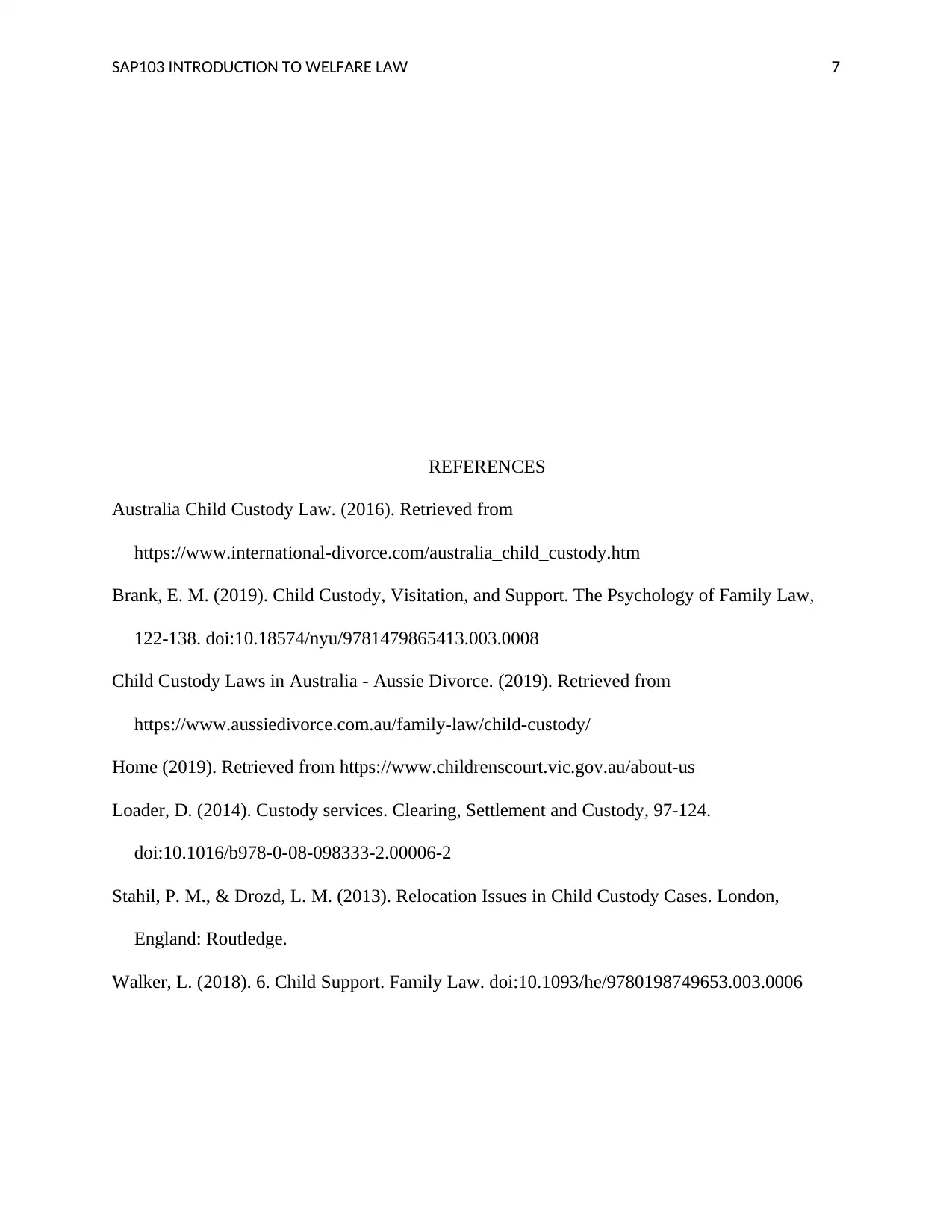
SAP103 INTRODUCTION TO WELFARE LAW 7
REFERENCES
Australia Child Custody Law. (2016). Retrieved from
https://www.international-divorce.com/australia_child_custody.htm
Brank, E. M. (2019). Child Custody, Visitation, and Support. The Psychology of Family Law,
122-138. doi:10.18574/nyu/9781479865413.003.0008
Child Custody Laws in Australia - Aussie Divorce. (2019). Retrieved from
https://www.aussiedivorce.com.au/family-law/child-custody/
Home (2019). Retrieved from https://www.childrenscourt.vic.gov.au/about-us
Loader, D. (2014). Custody services. Clearing, Settlement and Custody, 97-124.
doi:10.1016/b978-0-08-098333-2.00006-2
Stahil, P. M., & Drozd, L. M. (2013). Relocation Issues in Child Custody Cases. London,
England: Routledge.
Walker, L. (2018). 6. Child Support. Family Law. doi:10.1093/he/9780198749653.003.0006
REFERENCES
Australia Child Custody Law. (2016). Retrieved from
https://www.international-divorce.com/australia_child_custody.htm
Brank, E. M. (2019). Child Custody, Visitation, and Support. The Psychology of Family Law,
122-138. doi:10.18574/nyu/9781479865413.003.0008
Child Custody Laws in Australia - Aussie Divorce. (2019). Retrieved from
https://www.aussiedivorce.com.au/family-law/child-custody/
Home (2019). Retrieved from https://www.childrenscourt.vic.gov.au/about-us
Loader, D. (2014). Custody services. Clearing, Settlement and Custody, 97-124.
doi:10.1016/b978-0-08-098333-2.00006-2
Stahil, P. M., & Drozd, L. M. (2013). Relocation Issues in Child Custody Cases. London,
England: Routledge.
Walker, L. (2018). 6. Child Support. Family Law. doi:10.1093/he/9780198749653.003.0006
1 out of 7
Related Documents
Your All-in-One AI-Powered Toolkit for Academic Success.
+13062052269
info@desklib.com
Available 24*7 on WhatsApp / Email
![[object Object]](/_next/static/media/star-bottom.7253800d.svg)
Unlock your academic potential
Copyright © 2020–2025 A2Z Services. All Rights Reserved. Developed and managed by ZUCOL.





